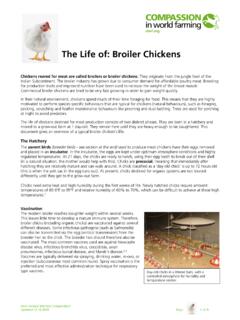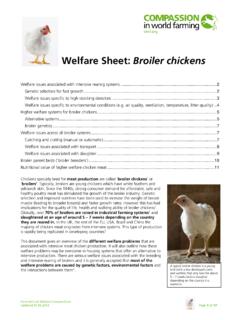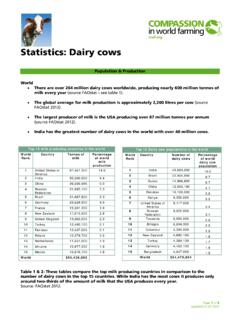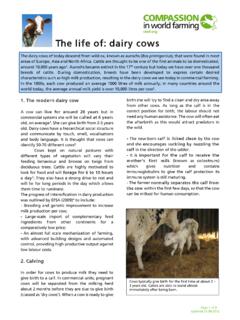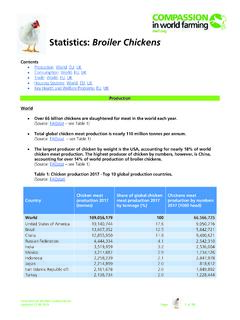Transcription of The life of - Pigs - Compassion in World Farming
1 Page 1 of 13 Last updated The life of - Pigs The domestic pig of today originates from the European wild boar, although there are still wild boars today1. The domestication of pigs is thought to have started about 7000 to 8000 BC2 3. The modern domesticated pig has a smaller head in proportion to the body, a mostly curled tail, less hair and a thicker layer of fat than wild boars. They now breed at any time of the year with more than one litter annually4. While the physical appearance has changed, the domesticated pig still has most of the behavioural repertoire of the wild boar5 6 7.
2 Until the 1950 s, Farming was often mixed (crops and livestock) with only a few pigs. Female breeding pigs were kept outside in the summer, with a wallowing pit and shade. Animals kept indoors were housed in loose pens, normally bedded with straw8. Wild boars are found in a range of habitats, often close to wooded areas and river valleys. They live in small family groups consisting of 2-4 sows and their young. The group ranges over hundreds of kilometres. Pigs are very intelligent, highly sociable animals. They are omnivores, having a varied diet, mostly high in fibre.
3 Normally pigs spend much of their time foraging and rooting for food. Pigs make nests for sleeping and huddle together for warmth. Sows construct elaborate nests prior to giving birth. They frequently wallow in mud for cooling and skin care (skin parasites get rubbed off with the mud). Designated toilet areas in their territory are used for dunging. Studies of domestic pigs that have either escaped (called feral pigs)9 or pigs kept in semi-natural enclosures have shown that they display the diverse behavioural repertoire of their wild ancestor10.
4 Modern pigs Today, more than a billion pigs are slaughtered in the World each year for meat, making them the most common mammal farmed for meat11. Left: Large White sows. Right: Wild Boar. Modern pigs have very different body shape to that of their ancestors, but pigs have retained many of the behaviours of their wild counterparts Over 1 billion pigs are slaughtered in the World each year. Page 2 of 13 Last updated Housing Throughout the World , over half of commercial pig Farming is highly intensive12. This takes place indoors and is also known as industrial pig production or factory Farming .
5 Adult female pigs are kept in close confinement systems throughout their lives. Their offspring are kept in barren pens at high stocking densities (expressed as the available floor area per animal), until they are ready to go for slaughter. Several alternatives to intensive Farming systems have been developed to overcome welfare concerns associated with intensive Farming . Most are based on traditional Farming systems that were commonly in use before industrialisation took place in the 1950s. Some use modern technology to achieve better welfare.
6 Breeding and rearing animals There are a number of different types of pig kept in Farming systems. The animals used for breeding include: 1. 2. 3. 4. 1. Gilts: young adult female pigs that have not yet produced a litter of piglets (called farrowing) Sows: adult female pigs that have farrowed one or more litters. 2. Dry sows: adult female pigs from weaning (separation from piglets) until farrowing. They are called dry because they are not producing milk to suckle piglets.
7 3. Farrowing sows: adult female pigs from farrowing until weaning. 4. Boars: adult male pigs used for mating with sows and gilts. The animals reared for meat include: 1. 2. 3. 4. Piglets: pigs from birth until weaning (at 2-4 weeks). 1. Weaners: pigs from weaning until the age of 10 weeks. 2. & 4. Rearing pigs: pigs from 10 weeks until slaughter age at about 6 months. 3. Growers or growing pigs: pigs in the early stage of rearing.
8 4. Fatteners or finishing pigs: pigs in the latter stage of rearing. Page 3 of 13 Last updated Intensive and alternative pig Farming Pigs are kept in a variety of Farming systems: Intensive Breeding animals are kept indoors in close confinement systems throughout their lives. Rearing animals are kept indoors in groups in barren pens, at high stocking densities. Temperature and ventilation in the buildings has to be closely controlled as the animals are unable to easily maintain body temperature by using pig-specific behaviour such as wallowing in mud.
9 Semi-intensive Both breeding and rearing animals are kept indoors in pens at high stocking densities with little or no access to bedding or litter. Farrowing sows are usually confined in crates. Enriched indoors Breeding animals and rearing animals are both kept indoors in spacious deep-bedded barns. The bedding may be straw, wood shavings or other material, which is replenished as needed. Farrowing sows are not confined. Outdoors Breeding animals are kept in outdoor paddocks. Rearing animals have access to outdoor areas. Most organic pig Farming is outdoors.
10 Extensive In some parts of the World , notably Spain, Sweden and Brazil, pigs are allowed to roam freely in semi-natural enclosures. Intensive pig Farming Enriched indoor pig Farming Outdoor (extensive) pig Farming Intensive pig Farming Most pigs used in intensive systems are based on a crossing of two breeds (Large White x Landrace). The breeding animals have been selected to maximise the number of piglets they can produce in a year. On average, modern sows have 10 piglets per litter and have litters per year13 but some are having 13 or 14 piglets per litter.
